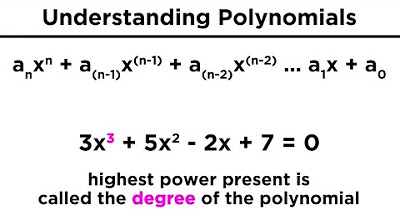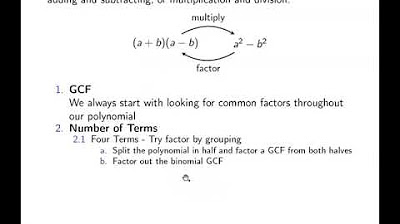Adding and Subtracting Polynomials
TLDRThe script provides an explanation of polynomials - expressions with multiple terms containing variables raised to positive whole number exponents. It discusses adding and subtracting polynomials by combining like terms, using the distributive property. It explains writing expressions vertically to neatly add/subtract terms of the same degree. Subtraction involves being careful with signs. The script then previews that multiplying polynomials is more complex, after first checking comprehension of addition and subtraction of polynomials.
Takeaways
- 😀 Polynomials are expressions/equations with multiple terms containing variables raised to positive whole number exponents
- 😊 To add/subtract polynomials, combine like terms by manipulating the coefficients and ignoring the exponents
- 🤔 Can align polynomials vertically to add/subtract terms of the same degree
- 😮 Leave a blank space if a particular degree is missing to avoid errors when adding/subtracting
- 🧐 Subtraction involves extra care with signs when working term-by-term
- 👍 Addition/subtraction of polynomials is straightforward - combine like terms
- 😀 Multiplication of polynomials is trickier than addition/subtraction
- 🤓 Constant terms can be thought of as x^0 since x^0 = 1
- 😊 Apply distributive property when combining like terms in polynomials
- 🤔 Bookkeeping degree terms properly is key to avoiding errors
Q & A
What is the definition of a polynomial?
-A polynomial is an expression or equation involving multiple terms that each include a variable raised to some positive whole number exponent, which may also be multiplied by some coefficient. The terms are listed in descending order, ending with any constant, which can be thought of as the X to the zero term, since X to the zero equals one.
What is the key thing to remember when adding and subtracting polynomials?
-The key is to combine like terms, because we want a single X to the fourth term, a single X cubed term, and so on, for any exponents that happen to be present in the expressions.
How do you combine like terms when adding and subtracting polynomials?
-You ignore the exponent for a moment and just recognize that the variables match. Then you only manipulate the coefficient. So five X cubed plus four X cubed becomes nine X cubed by adding the coefficients.
What is one way to neatly add or subtract polynomial expressions?
-You can write one expression over the other, lining up the degrees properly, so you can do arithmetic just like with small numbers. This helps avoid careless errors.
What happens when you subtract a negative number in a polynomial expression?
-Subtracting a negative number is the same as adding it. So if you subtract -3x^2, it actually becomes +3x^2.
Why do things get trickier when multiplying polynomials?
-When multiplying polynomials, you have to apply the distributive property multiple times across all the terms. This creates many more terms in the resulting expression.
What is an example of two polynomials being added together?
-An example is: (4x^3 + 2x^2 - 6x + 9) + (x^4 - 3x^2 + 6x - 4). You line up the expressions by degree and combine like terms.
What is an example of subtracting polynomials?
-An example is: (4x^3 + 2x^2 - 6x + 9) - (x^4 - 3x^2 + 6x - 4). You subtract each term, being careful about signs, and combine like terms.
Why is it important to line up polynomials properly when adding/subtracting them?
-Lining them up properly by degree ensures you are adding/subtracting the correct terms. Leaving blank spaces for missing degrees also helps avoid errors.
What remains the same when adding and subtracting polynomials versus numbers?
-Just like with regular numbers, you still combine like terms when adding and subtracting. The variable parts serve the role of the "units", while the coefficients are the quantities.
Outlines
📝 Adding and Subtracting Polynomials
This paragraph explains how to add and subtract polynomials by combining like terms. It uses the distributive property to demonstrate adding coefficients of terms with the same exponent. An example shows how to write one polynomial over another and add by lining up terms of the same degree. This allows tidy, clear arithmetic.
Mindmap
Keywords
💡polynomial
💡terms
💡exponent
💡distributive property
💡subtracting polynomials
💡multiplying polynomials
💡adding polynomials
💡degree
💡expression
💡coefficient
Highlights
Polynomials involve multiple terms with variables raised to positive whole number exponents.
Terms are listed in descending exponent order, ending with any constants.
To add/subtract polynomials, combine like terms using the distributive property.
Align terms by degree when adding/subtracting for easier bookkeeping.
Leave spaces for missing degrees to avoid errors.
Subtraction follows the same process but requires more sign awareness.
Multiplying polynomials is trickier than adding/subtracting them.
A polynomial expression/equation has multiple terms.
Each term includes a variable raised to a positive whole number exponent.
Terms are arranged in descending exponent order.
Constants can be seen as x^0 terms.
Add/subtract by combining like terms using the distributive property.
Line up terms by degree when adding/subtracting polynomials.
Leave spaces for missing degrees to avoid errors.
Subtracting polynomials needs more sign awareness.
Transcripts
5.0 / 5 (0 votes)
Thanks for rating:





